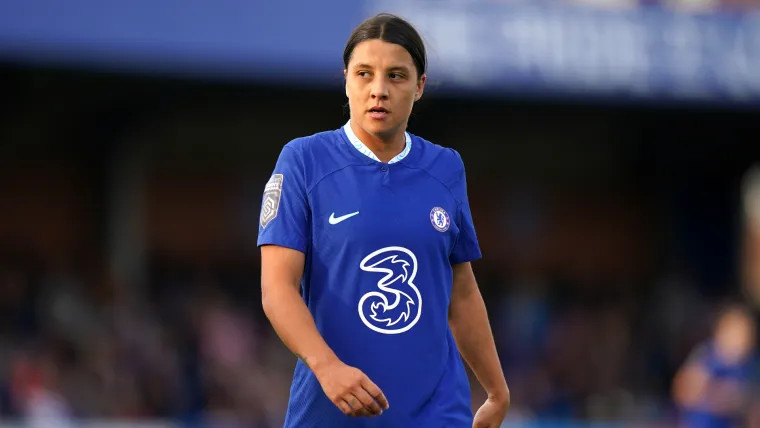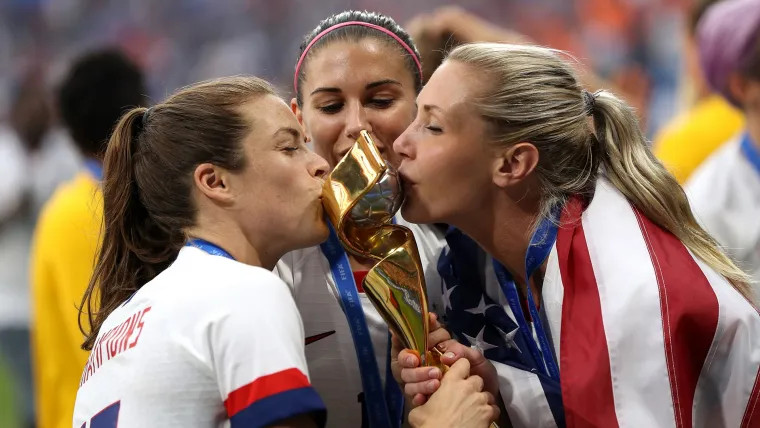Are you curious about how much female footballers in the UK earn? This article breaks down the salaries of women in football, comparing them to their male counterparts and exploring the factors that influence their pay. Find out more on CAUHOI2025.UK.COM. Understand women’s football salaries, pay gaps, and equal pay efforts.
1. Understanding Female Footballer Salaries in the UK
Determining the exact weekly earnings of female footballers in the UK can be challenging due to the lack of publicly available data from clubs. However, enough information exists to provide a general overview of the financial landscape for these athletes.
1.1. Average Weekly Earnings in the Women’s Super League (WSL)
The Women’s Super League (WSL) is the top tier of women’s football in England. While some star players earn substantial salaries, the average weekly wage paints a different picture.
- Reported Averages: A BBC report indicated that the average WSL player earns around £47,000 per year. This translates to approximately £900 per week before taxes and other deductions.
- Salary Range: A Telegraph investigation revealed that some WSL players earn as little as £20,000 annually, which is roughly £385 per week.
1.2. Top Earners in the WSL
While the average salary might seem modest, some elite players command significantly higher wages.
- Leah Williamson: The captain of Arsenal Women is reportedly on a salary of £200,000 per year, equating to about £3,850 per week.
- Sam Kerr: Playing for Chelsea, Sam Kerr is rumored to earn £400,000 annually, or approximately £7,700 per week.
 Sam Kerr Chelsea
Sam Kerr Chelsea
1.3. Factors Influencing Salaries
Several factors influence how much a female footballer gets paid a week in the UK:
- Club Revenue and Investment: Clubs with higher revenues and greater investment in their women’s teams can afford to pay higher wages.
- Player Performance and Marketability: Players with exceptional skills, a proven track record, and strong marketability are more likely to command higher salaries.
- Sponsorship and Endorsements: Endorsement deals with brands can significantly boost a player’s income.
- National Team Representation: Playing for a national team, especially one with a strong international presence, can increase a player’s market value.
2. The Stark Contrast: Comparing Female and Male Footballer Salaries
The disparity between the earnings of female and male footballers is significant. To illustrate this, let’s compare the weekly wages of WSL players to those in the Premier League.
2.1. Premier League Salaries
- Kevin De Bruyne: The Manchester City midfielder is rumored to earn £20 million per year, translating to approximately £385,000 per week. This means De Bruyne’s weekly earnings surpass what the highest-paid WSL player makes in a year.
2.2. Wage Gap Statistics
The wage gap between male and female footballers highlights the financial inequalities within the sport:
- Average Wage Ratio: The average Premier League player earns significantly more per week than the average WSL player earns in a year.
- Highest vs. Average: Even the highest-paid female footballers earn a fraction of what top male players make.
2.3. Reasons for the Disparity
Several factors contribute to the gender pay gap in football:
- Revenue Generation: Men’s football generates significantly more revenue through ticket sales, broadcasting rights, and merchandise.
- Historical Investment: Men’s football has historically received more investment, leading to greater infrastructure, marketing, and overall growth.
- Sponsorship Deals: Men’s teams and players attract more lucrative sponsorship deals due to higher viewership and commercial appeal.
- Media Coverage: Men’s football receives more media coverage, increasing its visibility and marketability.
3. Salaries in the United States: The National Women’s Soccer League (NWSL)
The United States has been a pioneer in women’s soccer, but salaries in the National Women’s Soccer League (NWSL) also reflect the financial challenges faced by female athletes.
3.1. NWSL Salary Structure
- Minimum Salary: In 2022, the NWSL and its players agreed to their first collective bargaining agreement, setting a minimum salary of $35,000 per year.
- Maximum Salary: Despite the minimum salary increase, the maximum salary in the NWSL is capped at $75,000 per year.
- Average Salary: The average salary for an NWSL player is approximately $57,000 per year.
3.2. Comparison with Major League Soccer (MLS)
The financial disparities between the NWSL and Major League Soccer (MLS) are evident:
- Minimum Salary: The minimum salary in MLS is higher than the maximum salary in the NWSL.
- Salary Cap: MLS has a significantly larger salary cap compared to the NWSL, allowing teams to invest more in player salaries.
- Designated Players: MLS teams can sign ‘designated players’ whose salaries exceed the salary cap, enabling them to attract top talent and pay higher wages.
3.3. Impact on Player Migration
The salary restrictions in the NWSL have led many top players to seek opportunities in Europe, where leagues are not bound by such stringent salary caps.
4. National Team Compensation: Bridging the Gap
Compensation for playing for national teams is another area where disparities have historically existed. However, progress is being made toward equal pay.
4.1. Equal Pay Agreements
Several countries have implemented equal pay agreements for their men’s and women’s national teams:
- England: The Football Association (FA) pays its men’s and women’s national team players the same match fees.
- Australia: Football Australia has committed to equal pay for its national team players.
- Norway: The Norwegian Football Federation was one of the first to implement equal pay for its national teams.
- United States: U.S. Soccer reached a landmark agreement to equalize pay for its men’s and women’s national teams.
 Alex Morgan
Alex Morgan
4.2. Bonus Structures and Prize Money
Despite progress in equal pay, significant gaps remain in bonus structures and prize money awarded to men’s and women’s teams for international tournaments.
- World Cup Prize Money: FIFA offers significantly more prize money to men’s teams compared to women’s teams. For example, the prize money for the 2022 Men’s World Cup was $440 million, while the prize money for the 2023 Women’s World Cup was $110 million.
- Bonus Disparities: Historically, women’s teams have received lower bonuses for winning major tournaments compared to their male counterparts.
4.3. FIFA’s Efforts to Close the Gap
FIFA has taken steps to address the prize money gap:
- Increased Investment: FIFA has increased the prize money for the Women’s World Cup.
- Equal Prize Money Goal: FIFA has stated its intention to award equal amounts of prize money at the men’s and Women’s World Cups by 2027.
- Player Bonus Structure: FIFA introduced a new player bonus structure for the 2023 Women’s World Cup, ensuring that all players receive a minimum of $30,000, with the amount increasing as their team progresses in the tournament.
5. The Path to Equal Pay: Challenges and Opportunities
Achieving equal pay in football requires addressing systemic issues and creating opportunities for growth.
5.1. Increasing Revenue in Women’s Football
Increasing revenue generation in women’s football is crucial for closing the pay gap:
- Broadcasting Rights: Securing more lucrative broadcasting deals for women’s leagues and tournaments can significantly boost revenue.
- Sponsorship Deals: Attracting more sponsorship deals by increasing the visibility and commercial appeal of women’s football.
- Ticket Sales: Promoting women’s matches and creating a fan base to increase ticket sales.
- Merchandise Sales: Developing and marketing merchandise to generate additional revenue.
5.2. Promoting Women’s Football
Increasing the visibility and popularity of women’s football is essential for driving revenue and attracting investment:
- Media Coverage: Increasing media coverage of women’s leagues and tournaments.
- Marketing Campaigns: Implementing marketing campaigns to promote women’s football and its athletes.
- Fan Engagement: Creating opportunities for fans to engage with women’s teams and players through social media, events, and community outreach programs.
5.3. Investing in Infrastructure and Development
Investing in infrastructure and development programs can help improve the quality of play and attract more talent:
- Training Facilities: Providing women’s teams with access to high-quality training facilities.
- Youth Development Programs: Investing in youth development programs to nurture young talent and create a pipeline of skilled players.
- Coaching and Support Staff: Hiring experienced coaches and support staff to provide players with the resources they need to succeed.
5.4. Addressing Systemic Issues
Addressing systemic issues such as gender bias and discrimination is crucial for creating a level playing field:
- Equal Opportunities: Ensuring that women have equal opportunities to participate in football at all levels.
- Representation: Increasing the representation of women in leadership positions within football organizations.
- Awareness Campaigns: Raising awareness about gender bias and discrimination in football.
6. Case Studies: Countries Leading the Way in Equal Pay
Some countries have made significant strides in promoting equal pay and opportunities in football.
6.1. Norway
The Norwegian Football Federation was one of the first to implement equal pay for its national teams.
- Equal Pay Agreement: The federation signed an agreement to pay its men’s and women’s national team players the same amount.
- Investment in Women’s Football: Norway has invested in women’s football, leading to increased participation and success.
6.2. Australia
Football Australia has committed to equal pay for its national team players.
- Collective Bargaining Agreement: The federation reached a collective bargaining agreement with its players to ensure equal pay.
- Increased Funding: Australia has increased funding for women’s football, supporting its growth and development.
6.3. United States
U.S. Soccer reached a landmark agreement to equalize pay for its men’s and women’s national teams.
- Equal Pay Agreement: The federation signed an agreement to pay its men’s and women’s national team players the same match fees and bonuses.
- Commitment to Equality: The agreement reflects a commitment to gender equality in football and sets a precedent for other countries to follow.
7. Frequently Asked Questions (FAQ)
Q1: How much do female footballers get paid a week in the WSL?
A1: The average weekly wage for a WSL player is around £900, but some players earn as little as £385 per week.
Q2: Who is the highest-paid female footballer in the WSL?
A2: Sam Kerr of Chelsea is rumored to earn £400,000 annually, or approximately £7,700 per week.
Q3: How does the NWSL salary structure compare to MLS?
A3: The minimum salary in MLS is higher than the maximum salary in the NWSL, and MLS has a much larger salary cap.
Q4: Which countries have equal pay agreements for their national teams?
A4: England, Australia, Norway, and the United States have equal pay agreements for their national teams.
Q5: What is FIFA doing to close the prize money gap between men’s and women’s World Cups?
A5: FIFA has increased the prize money for the Women’s World Cup and aims to award equal amounts of prize money by 2027.
Q6: What factors contribute to the gender pay gap in football?
A6: Revenue generation, historical investment, sponsorship deals, and media coverage all contribute to the gender pay gap.
Q7: How can revenue be increased in women’s football?
A7: By securing more lucrative broadcasting deals, attracting more sponsorship deals, increasing ticket sales, and developing merchandise sales.
Q8: What systemic issues need to be addressed to achieve equal pay in football?
A8: Gender bias, discrimination, and lack of representation need to be addressed to create a level playing field.
Q9: What is the minimum salary in the NWSL?
A9: The minimum salary in the NWSL is $35,000 per year.
Q10: Why have many top NWSL players moved to Europe?
A10: Salary restrictions in the NWSL have led many top players to seek opportunities in Europe, where leagues are not bound by such stringent salary caps.
8. Conclusion
The question of how much female footballers get paid a week in the UK reveals a complex landscape of financial disparities and ongoing efforts to achieve equal pay. While progress has been made, significant challenges remain in bridging the wage gap between male and female players. By increasing revenue in women’s football, promoting its visibility, investing in infrastructure, and addressing systemic issues, the sport can move closer to a future where all athletes are fairly compensated for their talent and dedication.
Do you have more questions about women’s football salaries or other related topics? Visit CAUHOI2025.UK.COM for more in-depth information and expert insights. We’re here to provide you with reliable, easy-to-understand answers to your questions. Contact us today to explore further and discover the information you need!
Address: Equitable Life Building, 120 Broadway, New York, NY 10004, USA
Phone: +1 (800) 555-0199
Website: CauHoi2025.UK.COM

